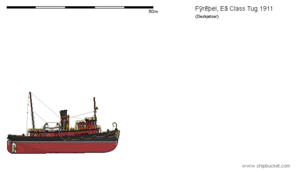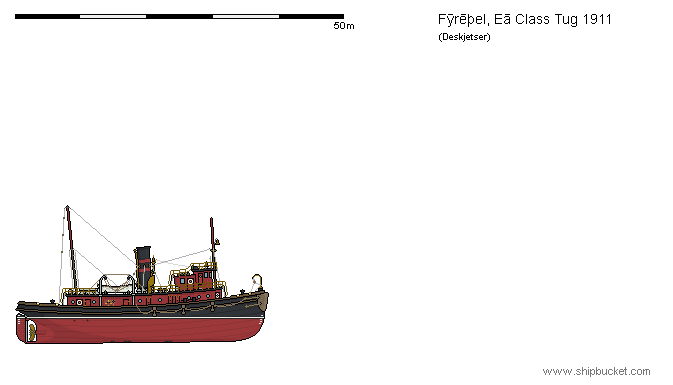Eā Class Sea Tug: Difference between revisions
Deskjetser (talk | contribs) No edit summary |
Deskjetser (talk | contribs) No edit summary |
||
| Line 59: | Line 59: | ||
Starling Line awarded the contract for a series of new powerful sea tugs to the Brēcænburg Scipwyrhta Intinga (Hereafter: BSI)<ref>(Lit: Brecanburg Shipwright Company)</ref>, on the 4th of January 1910. The design called for an incredible amount of power to be crammed into the relatively confined space of such a small vessel, with the boiler taking up almost all of the beam amidships; As such, range was considerably limited on high power tasks, while requiring a full complement of five stokers, which made the vessels expensive to operate at full capacity. These characteristics meant that the Eā's operated by Starling Line could often be seen moored alongside the harbour collier, with all hands shovelling coal into the chutes with earnest. | Starling Line awarded the contract for a series of new powerful sea tugs to the Brēcænburg Scipwyrhta Intinga (Hereafter: BSI)<ref>(Lit: Brecanburg Shipwright Company)</ref>, on the 4th of January 1910. The design called for an incredible amount of power to be crammed into the relatively confined space of such a small vessel, with the boiler taking up almost all of the beam amidships; As such, range was considerably limited on high power tasks, while requiring a full complement of five stokers, which made the vessels expensive to operate at full capacity. These characteristics meant that the Eā's operated by Starling Line could often be seen moored alongside the harbour collier, with all hands shovelling coal into the chutes with earnest. | ||
Starling Line received the first two of the order on the 5th of March 1911, and christened them Hal and Hadyn, after the then chairman of Starling sons. | Starling Line received the first two of the order from BSI on the 5th of March 1911, and christened them Hal and Hadyn, after the then chairman of Starling sons. | ||
[[File:Eā_Class_Sea_Tug,_1911.png|thumb|left|673px|]] | [[File:Eā_Class_Sea_Tug,_1911.png|thumb|left|673px|]] | ||
Revision as of 09:26, 19 October 2019
The Eā class of tug is the result of a contract from the Stærling Line[1] (Hereafter: Starling Line), to fill an expanding gap in capability of their current tugboats, as the last decade of competition with the Glasic Union Line had seen the average size of ocean liners increase dramatically; Vessels routinely displacing 30,000 tons were now a common sight in the ports of Fȳrland, and so the last generation of tugboats were quickly becoming overwhelmed.
Starling Line awarded the contract for a series of new powerful sea tugs to the Brēcænburg Scipwyrhta Intinga (Hereafter: BSI)[2], on the 4th of January 1910. The design called for an incredible amount of power to be crammed into the relatively confined space of such a small vessel, with the boiler taking up almost all of the beam amidships; As such, range was considerably limited on high power tasks, while requiring a full complement of five stokers, which made the vessels expensive to operate at full capacity. These characteristics meant that the Eā's operated by Starling Line could often be seen moored alongside the harbour collier, with all hands shovelling coal into the chutes with earnest.
Starling Line received the first two of the order from BSI on the 5th of March 1911, and christened them Hal and Hadyn, after the then chairman of Starling sons.
| Hal and Hadyn |
|---|



